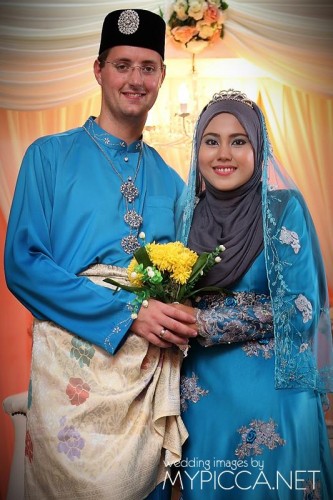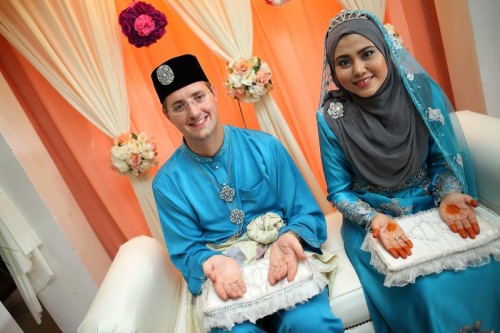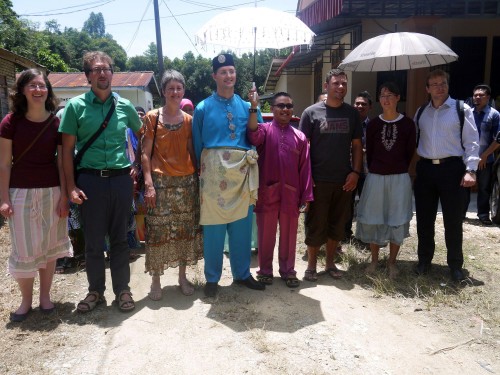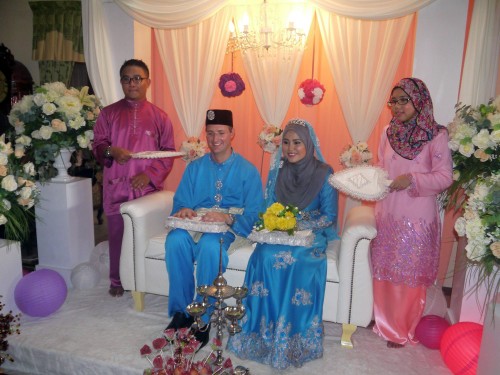In Deutschland fragt man sich ja manchmal, welchen der Termine man als Hochzeitstag feiert bzw. im Ring eingravieren soll. Die kirchliche oder die standesamtliche Hochzeit.
In der malaysischen Tradition hat man sogar gleich 3 Daten zur Auswahl: die offizielle Hochzeit in der Moschee, ein Empfang der Brauteltern sowie ein Empfang der Eltern des Bräutigams. Bei uns hat dann nur der Empfang bei den Brauteltern statt gefunden, vielleicht gibt es irgendwann mal ein kleines Fest hier in Deutschland.
Aber dieses Fest findet zuerst statt, in der Regel am Tag nach der offiziellen Vermählung, und es ist auch das Wichtigere und Größere der beiden Veranstaltungen. Das Fest beim Bräutigam findet manchmal erst Monate später statt und auch in einem kleineren Rahmen.
Veranstalter der Feste sind in Malaysia in der Tat die Eltern von Braut und Bräutigam und nicht das Brautpaar selbst. So kann man auf der Einladungskarte ganz oben auch zuerst die Namen der Eltern lesen. Prinzipiell dient das Fest dazu zu zeigen “Seht her, wir haben unser Kind verheiratet”.
Das bedeutet dann auch, dass die meisten Gäste von den Eltern eingeladen werden. Außerdem laden auch die Geschwister dann noch Freunde, Kollegen oder sogar Lehrer ein. Das führt dann auch dazu, dass die meisten Gäste das Brautpaar gar nicht kennen. Und dann auch auf dem Fest den Eltern gratulieren und mit dem Brautpaar selbst gar nicht erst spricht.
Der Empfang ist auch nicht mit einer deutschen Feier zu vergleichen.
Daher hier mal eine Beschreibung einige wichtigen Dinge, mehr Infos folgen im nächsten Teil.
Ort des Festes
In der Regel findet das Fest bei den Eltern zu Hause statt, teilweise werden auch Räume angemietet.
Bei uns war es im Hof des Hauses von Hidaya’s Eltern. Dort waren dann 2 größere Zelte, Tische, Stühle sowie das Buffet aufgebaut.
Dauer des Festes
Das Fest beginnt um die Mittagszeit und geht bis in die frühen Abendstunden, bei uns offiziell von 12 Uhr bis 18 Uhr.
Es ist dann auch nicht so, dass die Leute die ganze Zeit dort sind. Vielmehr ist es ein Kommen und Gehen. Wenn die Gäste gegessen haben, ein paar Worte mit den Eltern oder dem Brautpaar gewechselt haben und vielleicht noch ein paar Bilder gemacht werden, gehen diese so nach 1 Stunde wieder nach Hause.
Und wenn jemand mal etwas zu lange bleiben sollte und der Platz für neue Gäste benötigt wird, zögert die gastgebende Familie auch nicht mit Signalen zu zeigen, dass man doch dann auch mal nach Hause gehen sollte.
Die Uhrzeit auf den Einladungskarten bedeutet aber nicht, dass Gäste auch nur zu dieser Zeit da sind. So ist es auch kein Problem, wenn man später am Abend oder am folgenden Tag vorbei kommt. Selbst dann bekommen die Leute noch Essen oder Kekse und Kaffee angeboten.
Größe des Festes
Die Größe der Feier hängt mit der gesellschaftlichen Stellung sowie Vermögen der Eltern zusammen, da diese als Veranstalter auch für viele der Ausgaben wie Essen, Trinken und Co. aufkommen.
Bei unserem Fest wurden ca. 600 Einladungskarten verschickt und viele Leute zusätzlich per E-Mail, Facebook und Telefon eingeladen.
Von den Plätzen für das Essen gab es zeitgleich um die 100 Plätze. Am Ende waren über den Tag verteilt geschätzt so ca. 700 Gäste da.
Die Gäste waren wild gestreut mit Freunden und Schul-/Arbeitskollegen von Hidaya, Nachbarn, Kollegen der Eltern, Freunde der Geschwister, Verwandte, …
Prozession
Normalerweise befindet sich der Bräutigam zu Beginn des Festes nicht vor Ort, sondern kommt erst ca. 1 Stunde nach Beginn zusammen mit seiner Familie an. Da es Kommunikationsschwierigkeiten gab und ich außerdem noch damit beschäftigt war den richtigen Knoten in den Samping (Umhängerock) zu bekommen, bin ich nicht meine Familie aus dem Hotel abzuholen wie zuvor geplant.
Stattdessen wurde ich dann kurz nach der Ankunft meiner Familie informiert und habe mich dann “raus geschlichen” um diese am Nachbarhaus zu treffen. Nach ein paar Bildern ging dann von dort eine Prozession zum Ort des Festes los und die Landstraße war kurz für 2 Minuten gesperrt ;-).
Der Bräutigam trifft dann die Braut am Tor des Hauses und wir dort besonders begrüßt.
Bersanding
Nach der Ankunft am Haus der Braut kommt es zum traditionellen “Bersanding”. Hierbei sitzen Braut und Bräutigam auf einem “Pelamin”. Diese ist ein Couch / ein Thron auf einer speziell dekorierten Bühne mit Blumen auf beiden Seiten.
Dieses wird vor Ort bei einer der vielen Hochzeitsfirmen gemietet, von diesen vor Ort aufgebaut und später wieder abgeholt.
Neben Braut und Bräutigam auf beiden Seiten stehen enge Freunde oder Verwandte in traditionellen malaysischen Kostümen und einem Fächer um dem Brautpaar etwas Kühlung zu geben. Auf meiner Seite stand dann ein Cousin von Hidaya, da meine Gäste alle in normaler deutscher Kleidung kamen.
Wenn sich das Brautpaar gesetzt hat und alle Leute die ersten Bilder geschossen haben, kommen die Familienmitglieder zur Gratulation für Braut und Bräutigam. Hierbei werden vor dem Brautpaar aufgestellte Kräuter und Blätter auf die Hände gelegt und dann die Hände geschüttelt und einige persönliche Worte gesagt.
Gemäß der dortigen Tradition schütteln die Männer dann aber nur dem Bräutigam die Hand und gratulieren der Braut ohne Berührung. Wenn dann alle mit dem Gratulieren durch sind, dann gibt es noch einige Bilder auf dem Pelamin mit den Familienmitgliedern hinter und seitlich des Brautpaars.
English: Sunday – Part 1
In Germany people sometimes discuss which date to define as anniversary and engrave in the wedding ring. This might either be the official ceremony at the city hall or the ceremony at the church.
In Malay tradition, there are even 3 dates to choose from: the official ceremony at the mosque, the reception of the bride’s parents and another reception of the groom’s parents. So far, we only had the reception at Hidaya’s parents’ house. Maybe we will do another reception here in Germany after we settled down together.
But the reception for the bride’s side is the first event, taking place shortly after the official ceremony. And it’s also the more important and the bigger of the two events. The reception of the groom’s side sometimes takes places only weeks or months later and normally is also smaller.
The receptions in Malaysia are hosted by the parents and not the bridal couple. Thus, the invitation card is listing the names of the parents at the very top. The reception is very important to the parents and also has the role to show to relatives, neighbours and family “See, our kid got married”.
This also means that most of the guests are invited by the parents. Also siblings invite their friends, colleagues or even teachers. So at the end, most of the guests know neither bride nor groom. And some come to the event, bring their wishes to the parents and do not even talk to the couple.
The reception is very different than a wedding celebration in Germany. Thus I want to describe some of the important parts. More will follow in the next entry.
Location of the reception
Normally, the reception will take place at the house of the parents. If the parents are living in the city or an apartment or do not have enough space at home, people will rent some hall for the reception.
For us, it took place at the courtyard of Hidaya’s parents’ house. They put two canopies, tables, chairs as well as the buffet there.
Duration of the reception
Our reception started at 12 noon and officially ended at 6 p.m. Though the guests won’t be there for 6 hours. Rather guests are coming and leaving and then the next are coming. The guest will only stay around 1 hour and will leave after talking to the couple or the parents, eat and drink and maybe some pictures.
But the time on the invitation card does not mean that guests can’t come at any other time. In Malaysia, it’s common that guests will only come later in the evening or even on the next day. Even then, all guests will be treated nicely and will get food, coffee or some cookies.
Size of the reception
The size of the events depends on social position of the parents as they invite the guests and also are hosting the event and thus will pay most of the expenses for food, drinks and other stuff.
For our event, we sent around 600 invitation cards and invited many guests by E-Mail, Facebook or phone. The canopies could accommodate around 100 people at the same time. In total over the whole day we had around 700 guests for the reception.
Procession
Normally, the groom won’t be at the place of reception at the beginning but will only arrive around 1 hour after the start together with his family. Though there was some miscommunication and I was not yet fully dressed when some of Hidaya’s relatives went to pick up my family so I stayed at the house for the whole time.
Instead, I got hinted once they arrived and then sneaked out to meet them at the neighbors’ house. After taking some pictures we started some small procession to the place of reception and blocked the small countryside road for few minutes ;-).
The bride will wait at the gate to meet the groom and will welcome him there.
Bersanding
After the arrival, the traditional „Bersanding“ ceremony will take place. Bride and groom are sitting on the “Pelamin”. This is a couch or throne on a stage with a nice decoration and flowers. We rented the Palamin at one of the bridal boutiques nearby and the company set it up inside the house.
Close friends or relatives of the couple will stand on both sides of the couples wearing a traditional Malay dress. They will have a fan to give some cool air to the couple. On my side it was a cousin of Hidaya as all my relatives and friends didn’t wear the Malay dress.
After sitting down, all people will start taking many pictures of the couple. Then, close family members will come to bring their wishes to the couple for the wedding. For this, they will put some leafs or flowers onto the hands and then shake hands and say some personal greeting.
According to local tradition, men will only shake the hand of the groom and give the wishes to the bride without touching her. After all wishes have been done, it was time for some family pictures with the others standing beside and begin the couple.



